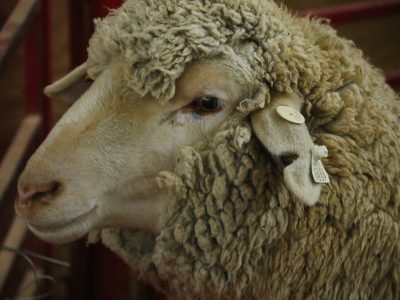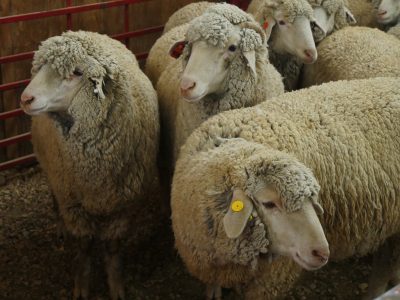As the last of the hay is put up, and signs of fall are in the air, many sheep producers across the Western range will begin thinking about the next season in the sheep industry: culling ewes. Often referred to as mouthing and bagging, culling is a management tool producers use to determine the age and soundness of ewes, and thus, their viability for the ranch’s production system.
Culling involves identifying individual animals that no longer benefit the operation and removing them from the flock. Ewes identified to be culled may have failed to produce a lamb, or have other underlying issues, limiting their ability to perform to their greatest potential.
With feed accounting for approximately 50% of the cost to raise and maintain ewes, removing unproductive females from the flock may be in the best interest for producers and their resources. Lamb crop at weaning is arguably the most important factor affecting the profitability of a sheep operation; increasing the lamb crop and maintaining productive ewes is a key goal for sheep producers looking to make a profit.
For most western range operations, culling is an ongoing process throughout the year. Ewes are typically identified to be culled after lambing, after weaning, and throughout the year when an issue arises with an individual. Any time issues with structure, reproduction, or health arise, ewes should be identified for culling.
Any ewes that failed to become pregnant and lamb during the lambing season likely have reproductive issues and are not suitable for the operation. These ewes are often marked and separated off into a group of “drys,” indicating they are not raising lambs. Older dry ewes may be difficult to spot but are typically in better body condition, with smaller udders, than their counterparts.
As ewes in large range operations begin to come off summer grazing grounds, producers typically evaluate the entire flock and cull more deeply. Sheep in a Western range operation need to be able to cover a lot of ground throughout the year while raising productive lambs; thus, skeletal structure and udder quality are of high importance. After weaning lambs, producers should evaluate the age, structural soundness, and udder quality of ewes to determine their productive potential prior to breeding.
Producers may choose to cull an individual for any number of reasons, including age, health and disease, genetics, or behavior and disposition. Factors influencing the decision to cull can be grouped into two main categories: voluntary and involuntary culling. Involuntary culling factors comprise those that negatively impact the bottom line regardless of market conditions, and typically include reproductive issues and severe health challenges.
Most other reasons for culling are considered voluntary. Typically, voluntary culling is based on factors that prevent females from performing at their highest potential but could be overlooked in a favorable market with high profit margins. Voluntary culling factors may include poor structure, assistance at lambing, mothering ability, udder quality, number of lambs weaned, lamb weaning weight, body condition score, genetics, disposition, or age.
According to the National Animal Health Monitoring System, 14 percent of ewes were culled from the national flock in 2011, citing age as the primary reason for removing females. Ewes are most productive between 3-6 years of age, with ewes in Western range operations averaging 5-6 years of age at culling.
While ewes in range flocks are typically culled by 6 years of age, these females may be able to remain productive under alternative management strategies, such as in a farm flock. When evaluating females based on age, producers should inspect the ewe’s teeth for signs of wear and tear, which limits the ability to graze.
 The National Animal Health Monitoring System has also identified hard bag and mastitis as primary reasons for culling ewes. Hard bag, which affects both halves of the udder, may be caused by ovine progressive pneumonia or mastitis, an infection of the udder. Both conditions lead to minimal or no milk production in the affected gland, potentially resulting in lambs starving or not receiving adequate nutrition for growth.
The National Animal Health Monitoring System has also identified hard bag and mastitis as primary reasons for culling ewes. Hard bag, which affects both halves of the udder, may be caused by ovine progressive pneumonia or mastitis, an infection of the udder. Both conditions lead to minimal or no milk production in the affected gland, potentially resulting in lambs starving or not receiving adequate nutrition for growth.
In 2011, hard bag and mastitis resulted in 7.1 and 6.7 percent of ewes being culled from the national flock respectively. When evaluating for these conditions, udders should be palpated to ensure the lack of lumps or hardness, and teats should be functional and of normal size. Only ewes with sound udders should be retained within the flock.
It is advised to restrict the breeding season to two or three heat cycles, ideally just two. Mature ewes that do not conceive and sustain a pregnancy should be culled. Pregnancy scanning is useful for identifying open ewes, particularly valuable for ewe lambs, as they can be sold at higher prices than yearling ewes that fail to lamb.
Ewes that lamb late in the season are also candidates for culling since those that lamb early are typically more productive. While dystocia, or difficult birthing, is a complex issue, research shows that culling ewes requiring assistance during lambing can reduce its occurrence. Some producers may even cull lambs from assisted deliveries. Ewes whose lambs are small, weak, or slow to suckle should be noted as potential culls as well.
Ewes that reject or harm their lambs should be culled for disposition. Similarly, ewes that fail to raise a lamb should also be culled, as no ewe can be profitable without producing a lamb. Exceptions can be made for ewes that fail to raise a lamb or twin lambs due to factors beyond their control, such as predation or accidental death. However, if too many excuses are made for a ewe, it might indicate that she belongs in the cull pen.
Once producers identify which animals should be culled from the operation, they need to consider whether to cull immediately or keep them on the operation for a time to maximize market opportunities. When making this decision, it’s important to contemplate two questions: 1) What are the expected feed costs to add weight to the cull pen before marketing? and 2) Will the expected return on investment from feeding outweigh the additional input costs?
Evaluating seasonal prices for cull ewes and considering the environmental conditions for the operation will help producers make the decision of when to market their culls. Ultimately, removing ewes that are not producing to their greatest potential will benefit your flock and operation in the long run.
McKenna Julian is the University of Wyoming Extension agriculture and natural resources educator serving Lincoln County. She can be reached at mbrinton@uwyo.edu or (307) 828-4093.




